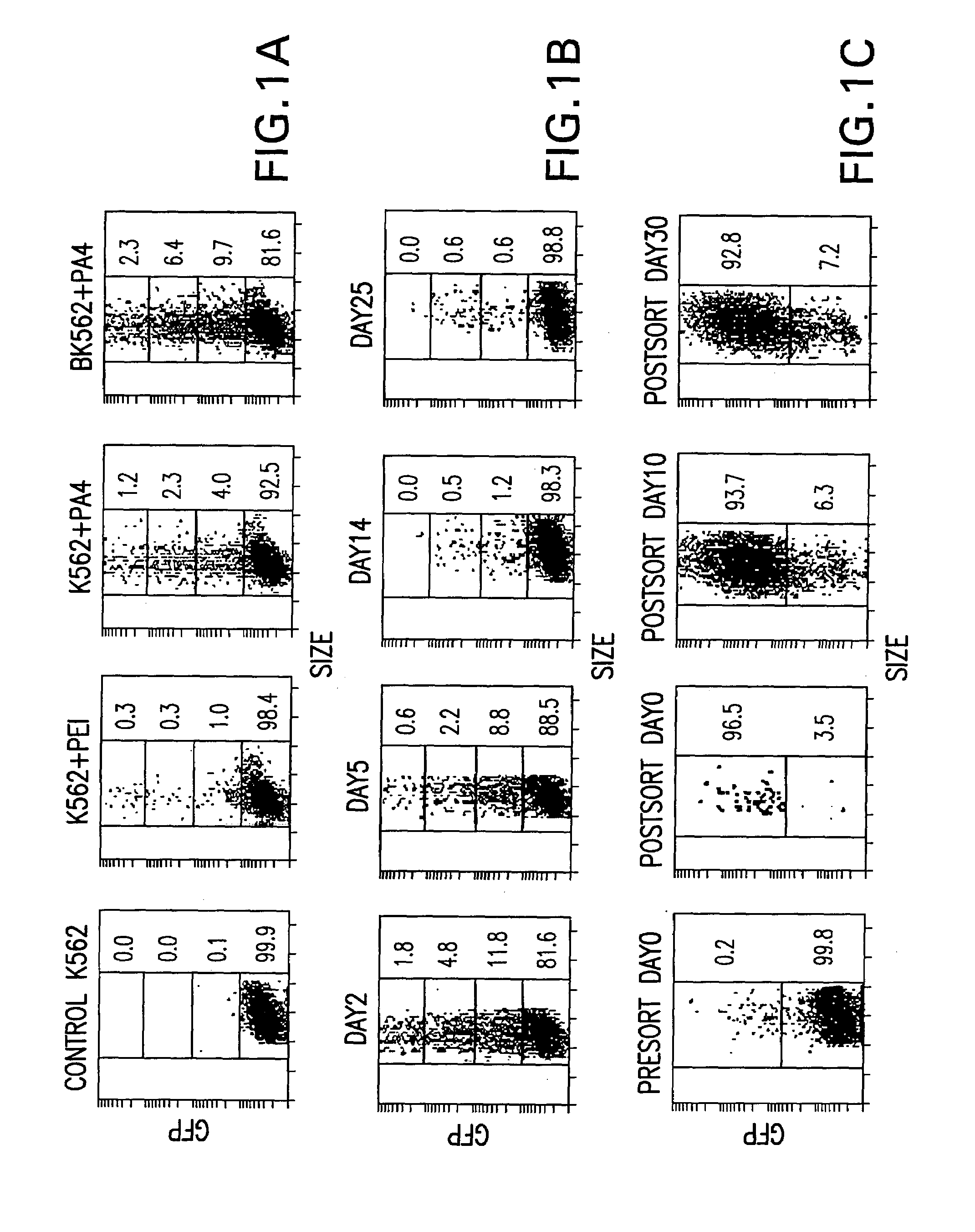Methods for delivering biologically active molecules into cells
a technology of biologically active molecules and cells, applied in the field of methods, can solve the problems of low transfection efficiency in primary cells, difficult production of clinical grade virions, and inability to achieve clinical grade virions,
- Summary
- Abstract
- Description
- Claims
- Application Information
AI Technical Summary
Problems solved by technology
Method used
Image
Examples
example 1
Methods
A. Biotinylation of Cell Surfaces
1. Direct Biotinylation of Cell Surfaces
[0031]Human chronic myelogenous leukemia cells, line K562, are biotinylated as follows: 106 cells are incubated in a final concentration of 0.5 ng sulfo-NHS-Biotin per cell (Pierce Chemicals, Rockford, Ill.) in phosphate buffered saline (PBS) for 30 minutes at 4° C. and washed twice with PBS. For human erythroleukemia (HEL) cells, 5×105 cells are incubated in a final concentration of 1.0 ng sulfo-NHS-Biotin per cell, and for buffy coat cells, 5×106 cells are incubated in a final concentration of 0.1 ng sulfo-NHS-Biotin per cell. After biotinylation, cells are washed with PBS and transferred into 24-well plates in 1.5 ml of adequate cell media. Non-biotinylated cells are used as a control.
[0032]Human cells in situ are biotinylated by injecting sulfo-NHS-Biotin into the target tissue or organ at an amount of at least approximately 1 ng per cell. Human blood cells treated ex vivo using apheretic techniques ...
example 2
Avidin-FITC Complexes undergo Endocytosis after Binding to Biotinylated Cells
A. Directly Biotinylated Cells
[0043]Untreated K562 cells show very little autofluorescence or nonspecific binding of Av-FITC as assessed by flow cytometry and fluorescence microscopy. When Av-FITC is added to biotinylated K562 cells, Av-FITC is evenly distributed on cell surfaces. Thirty minutes after addition, fluorescein is detected inside endosomal compartments in all cells. The fluorescence gradually shifts from the cell surface to the cell interior during the next 24 hours, which is demonstrated by comparing the fluorescence and phase images of the same microscopic field. The fluorescein remains inside the cells without being recycled to the surface. No internalization is observed when cells are incubated at 4° C., and no exocytosis of fluorescent complexes is detected. A similar pattern and time-course can be observed using K562 and Jurkat cell lines.
[0044]Flow cytometry is used to determine whether a...
example 3
PEI-Avidin Conjugates Condense DNA and Efficiently Transfect Cultured Cells
A. Directly Biotinylated Cells
[0046]Three PEI-avidin conjugates were prepared with increasing content of avidin as described in the Materials and Methods. PA4, PA8 and PA16 define conjugates with avidin to PEI molar ratios of 4, 8 and 16 respectively. As assessed by gel retardation, cationic binding by PEI and all the PA conjugates completely neutralized the anionic charge of the plasmid DNA to prevent its electrophoresis at the N:P ratio of 3.2. Due to the additional cationic charge of avidin (see Savage, M D et al. 1994, Avidin-biotin Chemistry: A Handbook, 2nd Ed., Pierce Chemical Co., Rockford, Ill.) and possible differences in the protonation profile of the conjugated PEI, the PA conjugates caused gel retardation at a proportionally lower PEI level. As expected, the PA16 conjugates are most cationic with complete DNA gel retardation at an N:P ratio of 0.8.
[0047]Gene transfer efficiencies in K562 and biot...
PUM
| Property | Measurement | Unit |
|---|---|---|
| Surface | aaaaa | aaaaa |
Abstract
Description
Claims
Application Information
 Login to View More
Login to View More - R&D
- Intellectual Property
- Life Sciences
- Materials
- Tech Scout
- Unparalleled Data Quality
- Higher Quality Content
- 60% Fewer Hallucinations
Browse by: Latest US Patents, China's latest patents, Technical Efficacy Thesaurus, Application Domain, Technology Topic, Popular Technical Reports.
© 2025 PatSnap. All rights reserved.Legal|Privacy policy|Modern Slavery Act Transparency Statement|Sitemap|About US| Contact US: help@patsnap.com

